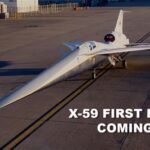
China’s potential development of a sixth-generation fighter jet featuring side-by-side seating has sparked speculation about a shift in combat roles and technological advancements in its military aviation. This unconventional design choice suggests the aircraft may prioritize enhanced crew coordination, advanced battle management capabilities, and potentially control of unmanned aerial vehicles (UAVs), marking a significant departure from traditional fighter configurations.
The emergence of images and mockups purportedly depicting this next-generation fighter has ignited discussion among military analysts and aviation enthusiasts. While details remain scarce and official confirmation is pending, the side-by-side seating arrangement indicates a focus on collaborative operations within the cockpit, potentially streamlining complex tasks and decision-making processes during high-intensity combat scenarios. “The biggest takeaway from all the models and images we’re seeing is the side-by-side cockpit,” noted an article from Yahoo News.
Design Implications and Potential Roles
The side-by-side configuration contrasts sharply with the tandem seating found in aircraft like the F-14 Tomcat or the single-seat arrangement prevalent in most modern fighters. This design choice suggests a mission profile that goes beyond traditional air-to-air combat. One of the primary reasons for this configuration could be to facilitate advanced battle management. A side-by-side setup allows for closer communication and shared situational awareness between the pilot and the weapons systems officer (WSO), or in this case, a mission systems operator. This could be crucial for managing a complex network of UAVs or coordinating attacks across multiple domains.
According to Peter Suciu, “Such a configuration hasn’t been seen since the U.S. Air Force’s F-111 Aardvark, which was retired in 1996.” The F-111 was designed for long-range strike missions, and its side-by-side seating was intended to reduce pilot workload during extended flights and enhance coordination in navigating and targeting.
In the context of China’s sixth-generation fighter, the side-by-side seating may signify a similar emphasis on long-range operations, potentially including strike missions, reconnaissance, and electronic warfare. It could also imply that the aircraft will serve as a command and control node, directing the actions of other aircraft and unmanned systems.
The potential integration of UAV control is another key consideration. With advancements in artificial intelligence and autonomous systems, future combat scenarios are likely to involve a mix of manned and unmanned platforms. A side-by-side cockpit could allow one crew member to focus on flying the aircraft while the other manages a team of drones, providing real-time intelligence, surveillance, and reconnaissance (ISR) data, or even engaging targets.
Technological Advancements and Stealth Capabilities
Beyond the unique seating arrangement, China’s sixth-generation fighter is expected to incorporate a range of advanced technologies. Stealth capabilities are likely to be a top priority, with the aircraft designed to minimize its radar cross-section and infrared signature. This could involve advanced shaping, radar-absorbent materials, and internal weapons bays.
Advanced sensors and data fusion systems are also crucial. The fighter is likely to feature a powerful active electronically scanned array (AESA) radar, capable of detecting and tracking targets at long ranges. Data from various sensors, including radar, infrared search and track (IRST) systems, and electronic warfare equipment, would be fused together to provide the crew with a comprehensive view of the battlespace.
Hypersonic capabilities are another area of interest. While there is no concrete evidence that China’s sixth-generation fighter will be capable of hypersonic flight, some analysts believe that it is a possibility. Hypersonic flight would allow the aircraft to reach distant targets much faster than conventional fighters, providing a significant advantage in terms of response time and survivability.
The engines powering the sixth-generation fighter are also likely to be a focus of development. China has been investing heavily in advanced jet engine technology, including variable cycle engines that can optimize performance for different flight regimes. These engines would need to provide high thrust, good fuel efficiency, and the ability to operate at high altitudes and speeds.
Strategic Implications and Geopolitical Context
The development of a sixth-generation fighter by China would have significant strategic implications for the region and the world. It would represent a major step forward in China’s military modernization efforts and would narrow the gap with the United States, which is also developing its own sixth-generation fighter under the Next Generation Air Dominance (NGAD) program.
The introduction of a highly capable sixth-generation fighter would enhance China’s ability to project power and assert its interests in the Indo-Pacific region. It could also alter the balance of power in key areas, such as the South China Sea and the Taiwan Strait.
The United States and its allies are closely monitoring China’s military developments, including its progress on sixth-generation fighter technology. The U.S. Air Force is pursuing its own NGAD program, which aims to develop a family of advanced air warfare systems, including a sixth-generation fighter, new weapons, and advanced sensors.
The competition between the United States and China in the field of military aviation is likely to intensify in the coming years. Both countries are investing heavily in advanced technologies and are seeking to maintain their edge in airpower. The development of sixth-generation fighters is a key part of this competition, and it will have a significant impact on the future of aerial warfare.
Analysis of Side-by-Side Seating
The decision to potentially adopt side-by-side seating is a significant design departure that requires careful consideration of the trade-offs involved. While it offers potential benefits in terms of crew coordination and battle management, it also presents some challenges.
One potential drawback is the increased frontal area of the aircraft, which could increase drag and reduce aerodynamic efficiency. This could be mitigated through careful shaping and the use of advanced materials, but it is still a factor to consider.
Another challenge is the need to integrate two sets of controls and displays into the cockpit. This could add complexity and weight to the aircraft. However, advancements in digital technology and human-machine interfaces could help to minimize these challenges.
Despite these potential drawbacks, the benefits of side-by-side seating may outweigh the costs, particularly if the aircraft is intended to perform a wide range of missions, including battle management and UAV control. The enhanced crew coordination and situational awareness afforded by this configuration could be crucial in complex and dynamic combat scenarios.
Expert Opinions and Speculations
Military analysts and aviation experts have offered various opinions and speculations about China’s sixth-generation fighter and the significance of the side-by-side seating arrangement. Some believe that it is a clear indication of a shift towards more collaborative and network-centric warfare. Others are more skeptical, suggesting that it may be a niche design intended for specific missions.
According to some reports, “the side-by-side configuration could allow one crew member to focus on flying the aircraft while the other manages a team of drones, providing real-time intelligence.” This aligns with the broader trend of integrating unmanned systems into military operations.
However, some experts caution against reading too much into the available images and mockups. They note that these may not accurately reflect the final design of the aircraft, and that many details are still unknown. It’s also important to remember that conceptual designs often change significantly before they become operational aircraft.
Ultimately, the true capabilities and mission profile of China’s sixth-generation fighter will not be known until it is officially unveiled and enters service. However, the available evidence suggests that it will be a highly advanced and capable aircraft, and that it will play a significant role in China’s military modernization efforts.
Comparison with Other Sixth-Generation Fighter Programs
It is important to consider China’s sixth-generation fighter program in the context of similar efforts in other countries, particularly the United States. The U.S. Air Force’s NGAD program is also aimed at developing a family of advanced air warfare systems, including a sixth-generation fighter.
While details about the NGAD program are also limited, it is expected to incorporate a range of advanced technologies, including stealth, advanced sensors, data fusion, and potentially hypersonic capabilities. However, the NGAD program is taking a different approach to crew configuration, with a greater emphasis on unmanned systems and artificial intelligence.
The NGAD program is envisioned as a “system of systems,” with a mix of manned and unmanned platforms working together to achieve air dominance. The manned component of the NGAD program is likely to be a single-seat fighter, with a focus on autonomous capabilities and the ability to control multiple unmanned systems.
The differences in approach between the Chinese and U.S. sixth-generation fighter programs reflect different priorities and strategic visions. China appears to be emphasizing crew coordination and battle management, while the United States is focusing on unmanned systems and artificial intelligence.
The Future of Air Warfare
The development of sixth-generation fighters represents a significant step forward in the evolution of air warfare. These aircraft are expected to be far more capable than existing fighters, with advanced stealth, sensors, and weapons. They are also likely to play a key role in network-centric warfare, integrating with other platforms and systems to achieve air dominance.
The integration of unmanned systems is a key trend in the future of air warfare. Sixth-generation fighters are likely to be able to control multiple drones, providing real-time intelligence, surveillance, and reconnaissance data, or even engaging targets. This will allow manned fighters to operate more effectively and efficiently, and to take on a wider range of missions.
Artificial intelligence is also expected to play a major role in the future of air warfare. AI algorithms will be used to process vast amounts of data from sensors, to identify targets, and to make decisions in real-time. This will allow pilots to focus on the most critical tasks, and to react more quickly to changing threats.
The development of sixth-generation fighters is a complex and expensive undertaking, but it is essential for maintaining air superiority in the 21st century. The countries that are able to develop and deploy these advanced aircraft will have a significant advantage in future conflicts.
Conclusion
China’s potential development of a sixth-generation fighter jet with side-by-side seating represents a bold and innovative approach to military aviation. While many details remain unknown, the available evidence suggests that this aircraft is intended to play a key role in China’s military modernization efforts and to enhance its ability to project power in the Indo-Pacific region.
The side-by-side seating arrangement is a significant design departure that reflects a focus on crew coordination, battle management, and potentially UAV control. This configuration could provide significant advantages in complex and dynamic combat scenarios, but it also presents some challenges in terms of aerodynamics and integration.
The development of sixth-generation fighters is a key trend in the future of air warfare, and it will have a significant impact on the balance of power in the world. The countries that are able to develop and deploy these advanced aircraft will have a significant advantage in future conflicts. The world is watching closely as China continues to develop and refine this revolutionary military technology. The completion of this project could redefine the future of air combat.
Frequently Asked Questions (FAQ)
1. What is a sixth-generation fighter jet?
A sixth-generation fighter jet represents the next evolution in air combat technology, surpassing current fifth-generation fighters like the F-35 and J-20. These aircraft are expected to incorporate advanced features such as enhanced stealth capabilities, advanced sensors, data fusion, hypersonic flight potential, directed energy weapons, and the ability to control unmanned aerial vehicles (UAVs). They are designed to operate in highly contested and complex airspaces, maintaining air superiority against advanced adversaries.
2. Why is the side-by-side seating arrangement in China’s potential sixth-generation fighter significant?
The side-by-side seating arrangement is unconventional for fighter jets, which typically feature single-seat or tandem-seat configurations. This design suggests a focus on enhanced crew coordination and collaborative decision-making within the cockpit. It may indicate that the aircraft is intended for more complex missions, such as advanced battle management, control of UAVs, electronic warfare, or long-range strike operations, where close communication and shared situational awareness between crew members are crucial.
3. What are the potential benefits of side-by-side seating in a fighter jet?
The potential benefits include:
- Enhanced Crew Coordination: Facilitates direct communication and shared situational awareness between the pilot and mission systems operator (or weapons systems officer).
- Improved Battle Management: Streamlines the management of complex data streams and coordination of multiple assets, including UAVs.
- Reduced Workload: Allows for task sharing and division of responsibilities, reducing individual workload during long or demanding missions.
- Increased Mission Flexibility: Enables the aircraft to perform a wider range of missions, from traditional air-to-air combat to advanced electronic warfare and reconnaissance.
4. What are the potential drawbacks of side-by-side seating in a fighter jet?
The potential drawbacks include:
- Increased Frontal Area: Can increase drag and reduce aerodynamic efficiency, potentially impacting speed and maneuverability.
- Increased Weight: Adding a second seat, associated controls, and displays can increase the overall weight of the aircraft.
- Complexity: Integrating two sets of controls and displays into the cockpit can add complexity to the design and operation of the aircraft.
- Ejection System Challenges: Design for a safe ejection system may be more complex than single or tandem seat arrangements.
5. How does China’s sixth-generation fighter program compare to the U.S. NGAD program?
Both China and the United States are developing sixth-generation fighter jets, but their approaches appear to differ. While details are limited for both programs, the U.S. NGAD (Next Generation Air Dominance) program seems to emphasize a “system of systems” approach, integrating a single-seat manned fighter with a network of unmanned systems and advanced AI. China’s potential side-by-side seating suggests a greater focus on crew coordination and battle management. Both programs aim to achieve air superiority through advanced stealth, sensors, weapons, and data fusion, but their specific design choices and operational concepts may vary based on their respective strategic priorities and technological capabilities. The US appears to be focusing on autonomous capabilities and integrating AI while China’s focus appears to be leaning towards crew coordination and battle management.









